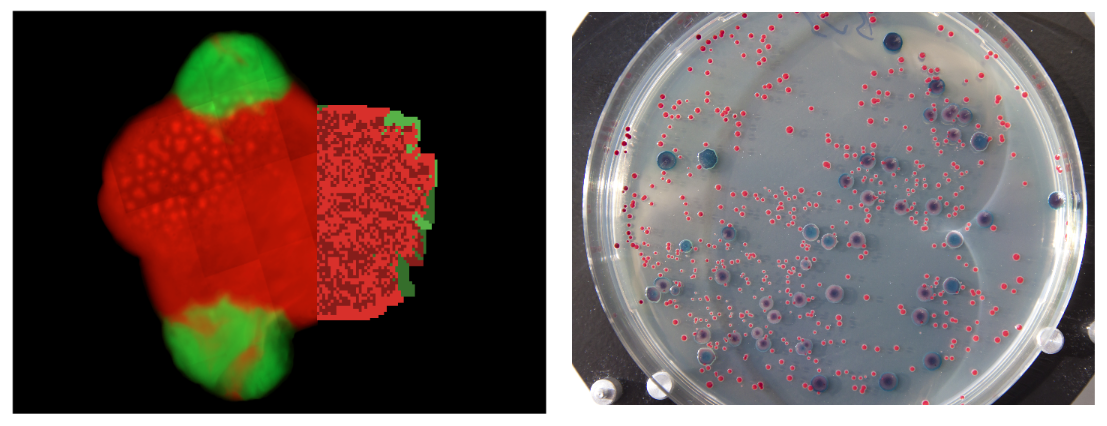|
Bacteria typically live in communities that are taxonomically and metabolically highly diverse. Due to the activities of the resident genotypes, many qualitatively and quantitatively different interactions emerge that can significantly impact the ecology and evolution of the community members involved.
One type of ecological interaction that seems to be particularly common in natural microbial communities is the unidirectional or reciprocal exchange of essential metabolites such as vitamins, amino acids, or nucleotides. Previous work of our group has established that two genotypes that reciprocally exchange essential amino acids can significantly benefit from this interaction relative to strains that have to produce both metabolites autonomously (i.e. division of metabolic labour). |
Given that the production of metabolites is costly to the producing strain, the question arises how cooperating genotypes prevent exploitation from free riders. These non-cooperators do not invest any resources into the cooperative interaction, but still gain a significant fitness advantage over cooperating types. In the long-run, competition between cooperators and non-cooperators for the cooperative good should lead to a collapse of the cooperative interaction.
Thus, one of the main goals of our work is to identify the molecular and ecological factors that facilitate the emergence of cooperative cross-feeding interactions as well as determine the conditions that maintain them in the long-run. We address this issue by exposing precisely defined microbial consortia to certain environmental conditions or selection pressures. These experiments are either performed on ecological time-scales, to monitor fitness-related shifts in the frequency distributions of the interacting populations, or in long-term evolution experiments, during which new genotypes arise by mutation and selection. These analyses are complemented by theoretical models that allow us for example to formulate testable predictions or verify the plausibility of a certain mechanism over a broad range of conditions.
Researchers:
Selected Publications:
D’Souza G, Shitut S, Preussger D, Yousif G, Waschina S, Kost C. (2018) Ecology and evolution of metabolic cross-feeding interactions in bacteria, Natural Product Reports, 35, 455-488. doi:10.1039/C8NP00009C.
Germerodt S, Bohl K, Lück A, Pande S, Schröter A, Kaleta C, Schuster S, Kost C. (2016). Pervasive selection for cooperative cross-feeding in bacterial communities. PLoS Computational Biology,12(6): e1004986. doi:10.1371/journal.pcbi.1004986.
Pande S, Kaftan F, Lang S, Svatoš A, Germerodt S, Kost C. (2016). Privatization of cooperative benefits stabilizes mutualistic cross-feeding interactions in spatially structured environments. The ISME Journal, 10, 1413-1423. doi:10.1038/ismej.2015.212.
D'Souza G, Kost C. (2016). Experimental evolution of metabolic dependency in bacteria. PLoS Genetics, 12(11): e1006364. doi:10.1371/journal.pgen.1006364.
Pande S, Merker H, Bohl K, Reichelt M, Schuster S, de Figueiredo LF, Kaleta C, Kost C.(2014). Fitness and stability of obligate cross-feeding interactions that emerge upon gene loss in bacteria. The ISME Journal, 8, 953-962. doi:10.1038/ismej.2013.211.
Germerodt S, Bohl K, Lück A, Pande S, Schröter A, Kaleta C, Schuster S, Kost C. (2016). Pervasive selection for cooperative cross-feeding in bacterial communities. PLoS Computational Biology,12(6): e1004986. doi:10.1371/journal.pcbi.1004986.
Pande S, Kaftan F, Lang S, Svatoš A, Germerodt S, Kost C. (2016). Privatization of cooperative benefits stabilizes mutualistic cross-feeding interactions in spatially structured environments. The ISME Journal, 10, 1413-1423. doi:10.1038/ismej.2015.212.
D'Souza G, Kost C. (2016). Experimental evolution of metabolic dependency in bacteria. PLoS Genetics, 12(11): e1006364. doi:10.1371/journal.pgen.1006364.
Pande S, Merker H, Bohl K, Reichelt M, Schuster S, de Figueiredo LF, Kaleta C, Kost C.(2014). Fitness and stability of obligate cross-feeding interactions that emerge upon gene loss in bacteria. The ISME Journal, 8, 953-962. doi:10.1038/ismej.2013.211.



